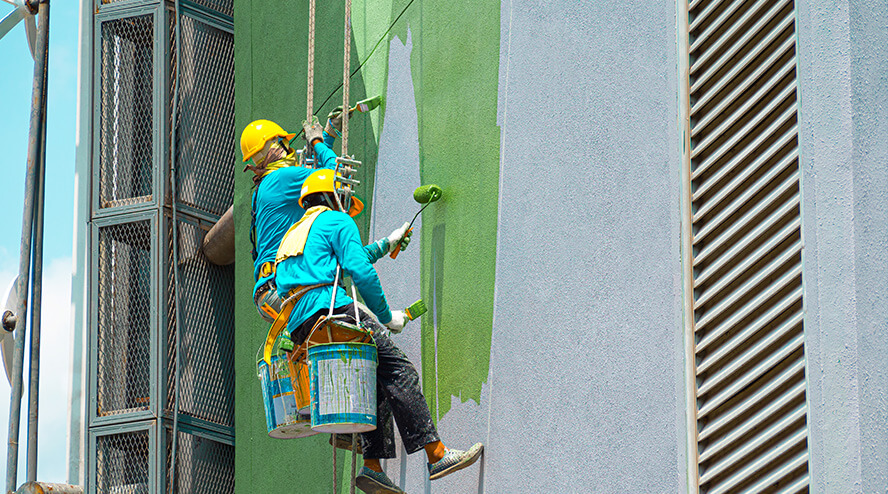Commercial Painting Services: Essential Factors to Consider for Your Project
In the world of commercial painting, meticulous planning and execution are key to achieving a professional and durable finish. Whether you’re renovating a small office space or undertaking a large-scale commercial building project, understanding the essential considerations can make a significant difference. This article delves into the critical aspects to keep in mind when embarking on a commercial painting project, with a special focus on the often overlooked but crucial role of ceiling painters.
Assessing the Scope of Work
The first step in any commercial painting project is to thoroughly assess the scope of work. This includes understanding the size of the area to be painted, the types of surfaces involved, and any specific challenges that might arise. For projects located in natural environments, additional considerations may be necessary to address environmental impact and protection. Detailed assessments help in accurate cost estimations and timelines, ensuring there are no surprises down the road. For instance, painting ceilings in large commercial spaces requires specialized equipment and expertise. Hiring professional ceiling painters can ensure that this part of the project is handled efficiently and safely, especially in areas with high ceilings or intricate architectural details.
Selecting the Right Materials
Choosing the right paint and materials is crucial for the success of your commercial painting project. Commercial environments often demand durable, long-lasting finishes that can withstand heavy traffic and regular cleaning. It’s important to select high-quality paints that offer excellent coverage, durability, and ease of maintenance. In areas like kitchens, bathrooms, and medical facilities, paints with antimicrobial properties are often preferred to maintain hygiene standards. For ceiling painting, opt for paints that are specifically formulated to prevent sagging and provide a smooth finish.
Hiring Experienced Professionals
The expertise of the painting crew plays a pivotal role in the quality of the finished project. Experienced commercial painters bring not only technical skills but also an understanding of how to minimize disruption to business operations. Look for contractors who are licensed, insured, and have a proven track record in commercial projects. Ceiling painters, in particular, should have experience with the unique challenges of painting overhead surfaces. This includes knowledge of the best techniques to avoid drips and ensure even coverage in hard-to-reach areas.

Planning and Coordination
Effective planning and coordination are essential to keep the project on track and within budget. This involves scheduling work during off-peak hours or weekends to minimize disruption to your business. Clear communication between the project manager, painting crew, and other contractors is vital to ensure that everyone is on the same page. Creating a detailed project plan that outlines each phase of the painting process can help identify potential issues early and allow for timely adjustments. Coordination is especially important in multi-phase projects where painting is just one part of a larger renovation.
Safety Considerations
Safety is paramount in any commercial painting project. This includes ensuring that the painting crew adheres to all safety regulations and uses the appropriate personal protective equipment (PPE). For ceiling painting, this might involve using scaffolding or lifts, which requires additional safety measures. Make sure that your painting contractor has a comprehensive safety plan in place and that all workers are trained in the latest safety protocols. This not only protects the workers but also minimizes liability for your business.
Environmental and Health Concerns
Modern commercial painting projects increasingly prioritize environmentally friendly practices. This includes using low-VOC (volatile organic compounds) paints that reduce harmful emissions and improve indoor air quality. These eco-friendly options are particularly important in settings like schools, hospitals, and office buildings where air quality can directly impact occupants’ health. Additionally, consider the long-term maintenance of painted surfaces. High-quality, durable paints may have a higher upfront cost but can result in savings over time by reducing the need for frequent repaints and repairs.
Quality Control and Final Inspection
Ensuring the highest quality of work involves regular inspections and a thorough final check. This includes inspecting the surfaces before painting begins to ensure they are properly prepared and free of any defects that could affect the paint's adhesion. Once the painting is completed, conduct a detailed inspection to check for consistency, coverage, and any missed spots. A professional contractor will be willing to address any issues and make necessary touch-ups to ensure the final result meets your expectations. Commercial painting projects require careful planning, the right materials, skilled professionals, and stringent safety measures. By considering these essential factors, you can ensure a successful project that enhances the appearance and longevity of your commercial space. Whether it’s the walls, trim, or ceilings, investing in professional painting services will yield a high-quality, durable finish that reflects well on your business. Remember, the details matter. From selecting the right paint to hiring specialized ceiling painters, each decision contributes to the overall success of your commercial painting project. With thorough preparation and expert execution, you can achieve a transformation that not only looks great but also stands the test of time.
Ideas, requests, problems regarding TWiki? Send feedback
